Environmental Management Accounting: Toshiba and Fujitsu
VerifiedAdded on 2021/04/07
|20
|3768
|68
Report
AI Summary
This report provides an in-depth analysis of Environmental Management Accounting (EMA), emphasizing its importance in modern business strategy. It begins by defining EMA and its role in promoting sustainability and the triple bottom line. The report then outlines the benefits of implementing EMA, including improved product pricing, identification of hidden costs, and competitive advantage. The core of the report consists of case studies of Toshiba and Fujitsu, demonstrating how these companies have applied EMA principles. Toshiba's T-COMPASS method and Fujitsu's environmental accounting practices are examined, highlighting their strategies for reducing environmental impact, measuring performance, and achieving economic benefits. The analysis includes detailed financial data and performance metrics from both companies. The report concludes by emphasizing the overall advantages of integrating EMA into corporate strategy, showing how it benefits both the environment and the company's financial performance.
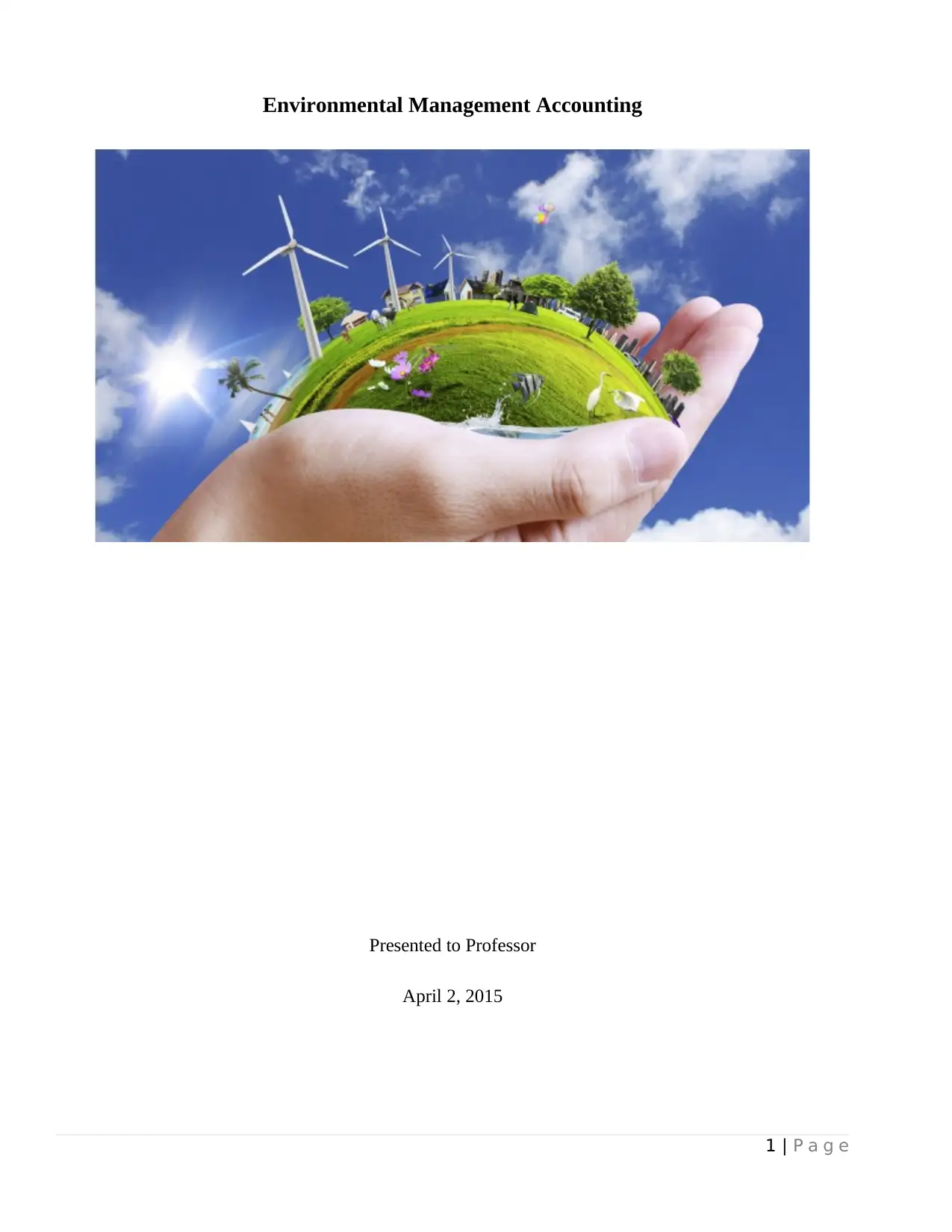
Environmental Management Accounting
Presented to Professor
April 2, 2015
1 | P a g e
Presented to Professor
April 2, 2015
1 | P a g e
Paraphrase This Document
Need a fresh take? Get an instant paraphrase of this document with our AI Paraphraser
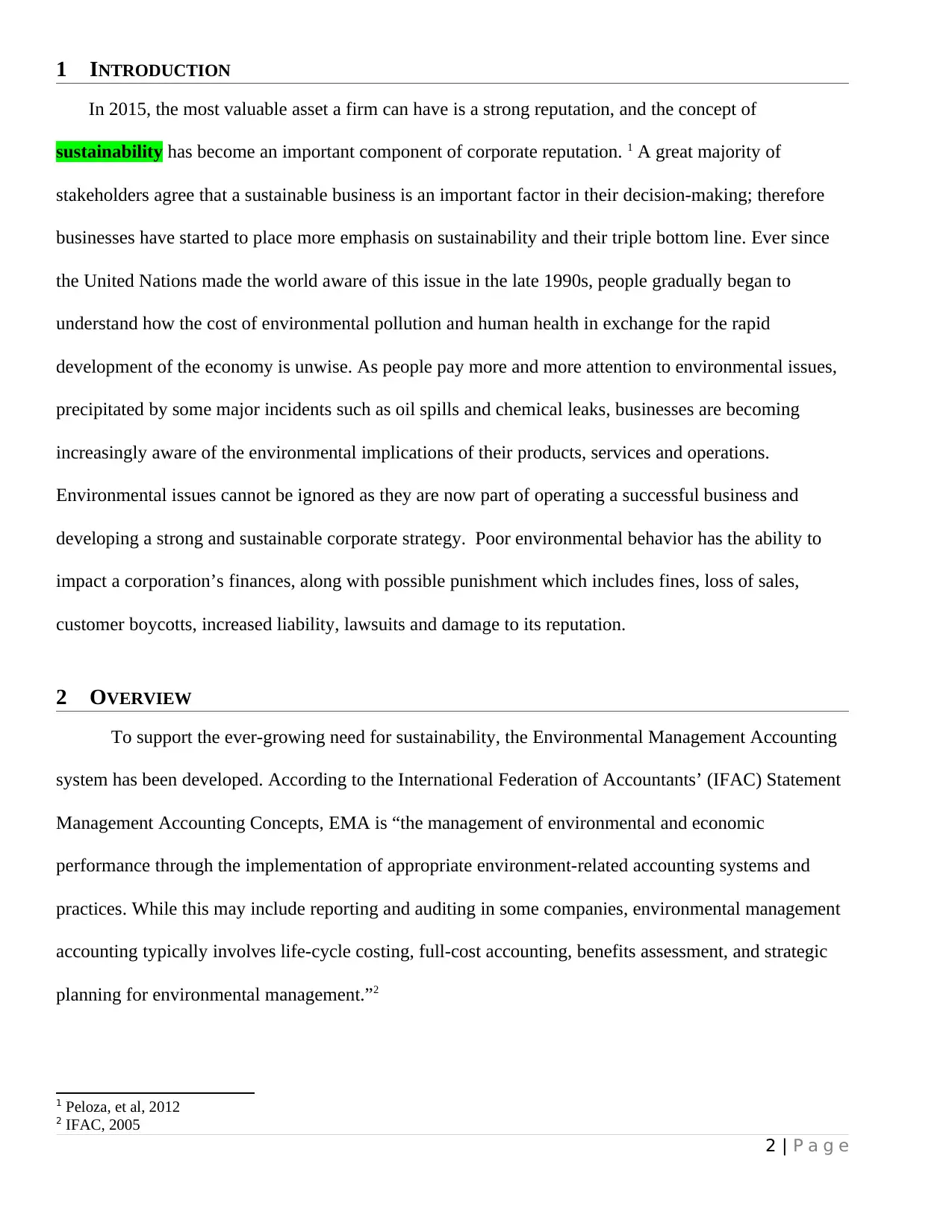
1 INTRODUCTION
In 2015, the most valuable asset a firm can have is a strong reputation, and the concept of
sustainability has become an important component of corporate reputation. 1 A great majority of
stakeholders agree that a sustainable business is an important factor in their decision-making; therefore
businesses have started to place more emphasis on sustainability and their triple bottom line. Ever since
the United Nations made the world aware of this issue in the late 1990s, people gradually began to
understand how the cost of environmental pollution and human health in exchange for the rapid
development of the economy is unwise. As people pay more and more attention to environmental issues,
precipitated by some major incidents such as oil spills and chemical leaks, businesses are becoming
increasingly aware of the environmental implications of their products, services and operations.
Environmental issues cannot be ignored as they are now part of operating a successful business and
developing a strong and sustainable corporate strategy. Poor environmental behavior has the ability to
impact a corporation’s finances, along with possible punishment which includes fines, loss of sales,
customer boycotts, increased liability, lawsuits and damage to its reputation.
2 OVERVIEW
To support the ever-growing need for sustainability, the Environmental Management Accounting
system has been developed. According to the International Federation of Accountants’ (IFAC) Statement
Management Accounting Concepts, EMA is “the management of environmental and economic
performance through the implementation of appropriate environment-related accounting systems and
practices. While this may include reporting and auditing in some companies, environmental management
accounting typically involves life-cycle costing, full-cost accounting, benefits assessment, and strategic
planning for environmental management.”2
1 Peloza, et al, 2012
2 IFAC, 2005
2 | P a g e
In 2015, the most valuable asset a firm can have is a strong reputation, and the concept of
sustainability has become an important component of corporate reputation. 1 A great majority of
stakeholders agree that a sustainable business is an important factor in their decision-making; therefore
businesses have started to place more emphasis on sustainability and their triple bottom line. Ever since
the United Nations made the world aware of this issue in the late 1990s, people gradually began to
understand how the cost of environmental pollution and human health in exchange for the rapid
development of the economy is unwise. As people pay more and more attention to environmental issues,
precipitated by some major incidents such as oil spills and chemical leaks, businesses are becoming
increasingly aware of the environmental implications of their products, services and operations.
Environmental issues cannot be ignored as they are now part of operating a successful business and
developing a strong and sustainable corporate strategy. Poor environmental behavior has the ability to
impact a corporation’s finances, along with possible punishment which includes fines, loss of sales,
customer boycotts, increased liability, lawsuits and damage to its reputation.
2 OVERVIEW
To support the ever-growing need for sustainability, the Environmental Management Accounting
system has been developed. According to the International Federation of Accountants’ (IFAC) Statement
Management Accounting Concepts, EMA is “the management of environmental and economic
performance through the implementation of appropriate environment-related accounting systems and
practices. While this may include reporting and auditing in some companies, environmental management
accounting typically involves life-cycle costing, full-cost accounting, benefits assessment, and strategic
planning for environmental management.”2
1 Peloza, et al, 2012
2 IFAC, 2005
2 | P a g e
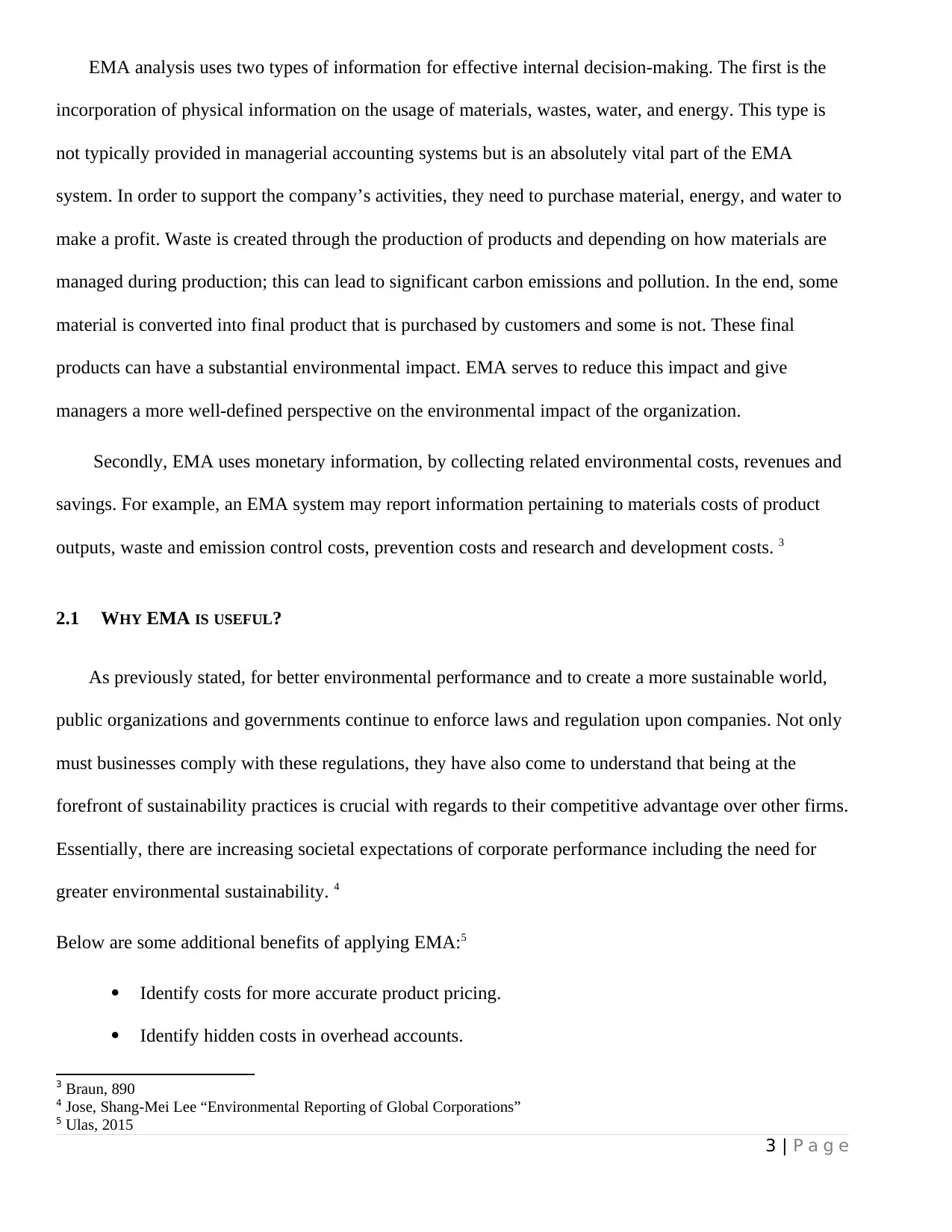
EMA analysis uses two types of information for effective internal decision-making. The first is the
incorporation of physical information on the usage of materials, wastes, water, and energy. This type is
not typically provided in managerial accounting systems but is an absolutely vital part of the EMA
system. In order to support the company’s activities, they need to purchase material, energy, and water to
make a profit. Waste is created through the production of products and depending on how materials are
managed during production; this can lead to significant carbon emissions and pollution. In the end, some
material is converted into final product that is purchased by customers and some is not. These final
products can have a substantial environmental impact. EMA serves to reduce this impact and give
managers a more well-defined perspective on the environmental impact of the organization.
Secondly, EMA uses monetary information, by collecting related environmental costs, revenues and
savings. For example, an EMA system may report information pertaining to materials costs of product
outputs, waste and emission control costs, prevention costs and research and development costs. 3
2.1 WHY EMA IS USEFUL?
As previously stated, for better environmental performance and to create a more sustainable world,
public organizations and governments continue to enforce laws and regulation upon companies. Not only
must businesses comply with these regulations, they have also come to understand that being at the
forefront of sustainability practices is crucial with regards to their competitive advantage over other firms.
Essentially, there are increasing societal expectations of corporate performance including the need for
greater environmental sustainability. 4
Below are some additional benefits of applying EMA:5
Identify costs for more accurate product pricing.
Identify hidden costs in overhead accounts.
3 Braun, 890
4 Jose, Shang-Mei Lee “Environmental Reporting of Global Corporations”
5 Ulas, 2015
3 | P a g e
incorporation of physical information on the usage of materials, wastes, water, and energy. This type is
not typically provided in managerial accounting systems but is an absolutely vital part of the EMA
system. In order to support the company’s activities, they need to purchase material, energy, and water to
make a profit. Waste is created through the production of products and depending on how materials are
managed during production; this can lead to significant carbon emissions and pollution. In the end, some
material is converted into final product that is purchased by customers and some is not. These final
products can have a substantial environmental impact. EMA serves to reduce this impact and give
managers a more well-defined perspective on the environmental impact of the organization.
Secondly, EMA uses monetary information, by collecting related environmental costs, revenues and
savings. For example, an EMA system may report information pertaining to materials costs of product
outputs, waste and emission control costs, prevention costs and research and development costs. 3
2.1 WHY EMA IS USEFUL?
As previously stated, for better environmental performance and to create a more sustainable world,
public organizations and governments continue to enforce laws and regulation upon companies. Not only
must businesses comply with these regulations, they have also come to understand that being at the
forefront of sustainability practices is crucial with regards to their competitive advantage over other firms.
Essentially, there are increasing societal expectations of corporate performance including the need for
greater environmental sustainability. 4
Below are some additional benefits of applying EMA:5
Identify costs for more accurate product pricing.
Identify hidden costs in overhead accounts.
3 Braun, 890
4 Jose, Shang-Mei Lee “Environmental Reporting of Global Corporations”
5 Ulas, 2015
3 | P a g e
⊘ This is a preview!⊘
Do you want full access?
Subscribe today to unlock all pages.

Trusted by 1+ million students worldwide
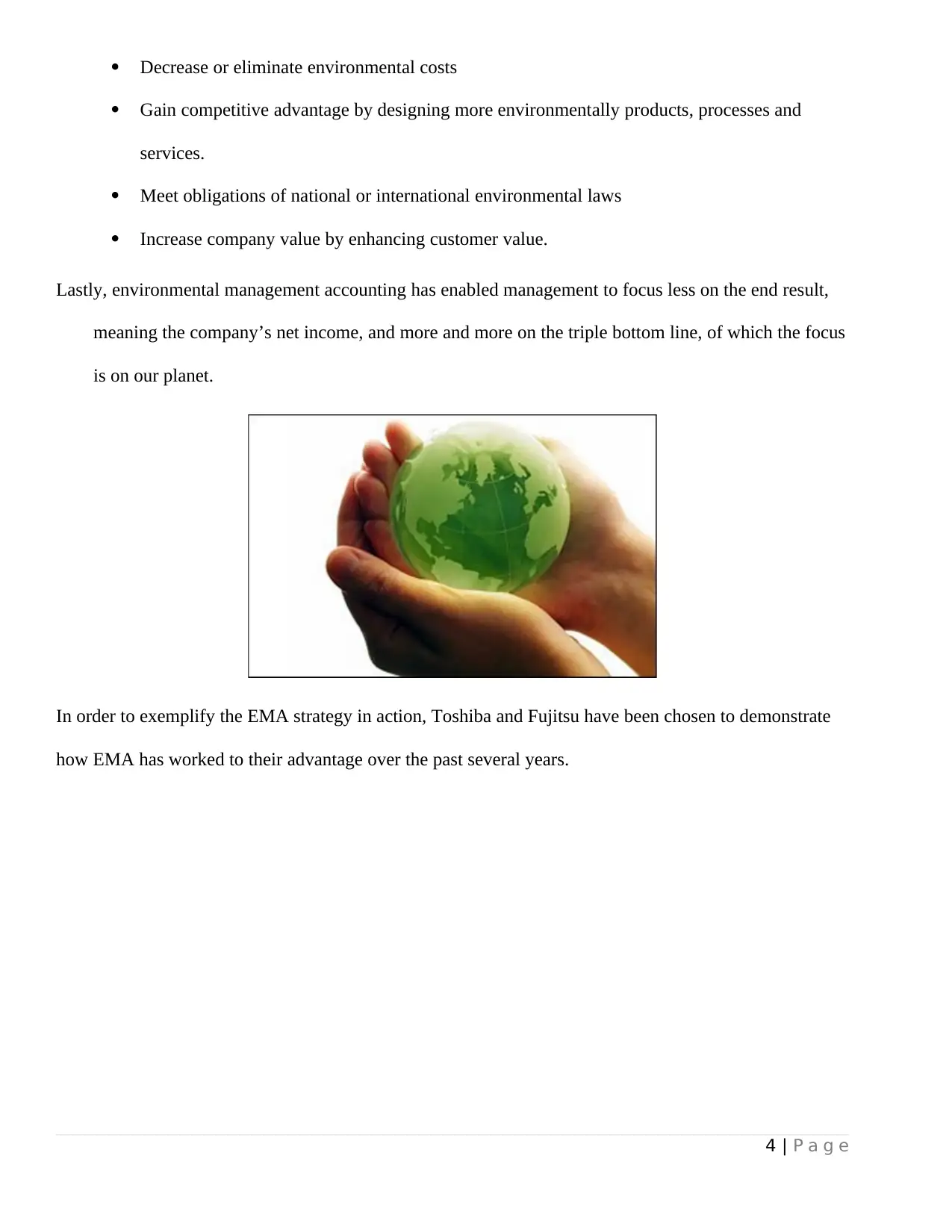
Decrease or eliminate environmental costs
Gain competitive advantage by designing more environmentally products, processes and
services.
Meet obligations of national or international environmental laws
Increase company value by enhancing customer value.
Lastly, environmental management accounting has enabled management to focus less on the end result,
meaning the company’s net income, and more and more on the triple bottom line, of which the focus
is on our planet.
In order to exemplify the EMA strategy in action, Toshiba and Fujitsu have been chosen to demonstrate
how EMA has worked to their advantage over the past several years.
4 | P a g e
Gain competitive advantage by designing more environmentally products, processes and
services.
Meet obligations of national or international environmental laws
Increase company value by enhancing customer value.
Lastly, environmental management accounting has enabled management to focus less on the end result,
meaning the company’s net income, and more and more on the triple bottom line, of which the focus
is on our planet.
In order to exemplify the EMA strategy in action, Toshiba and Fujitsu have been chosen to demonstrate
how EMA has worked to their advantage over the past several years.
4 | P a g e
Paraphrase This Document
Need a fresh take? Get an instant paraphrase of this document with our AI Paraphraser
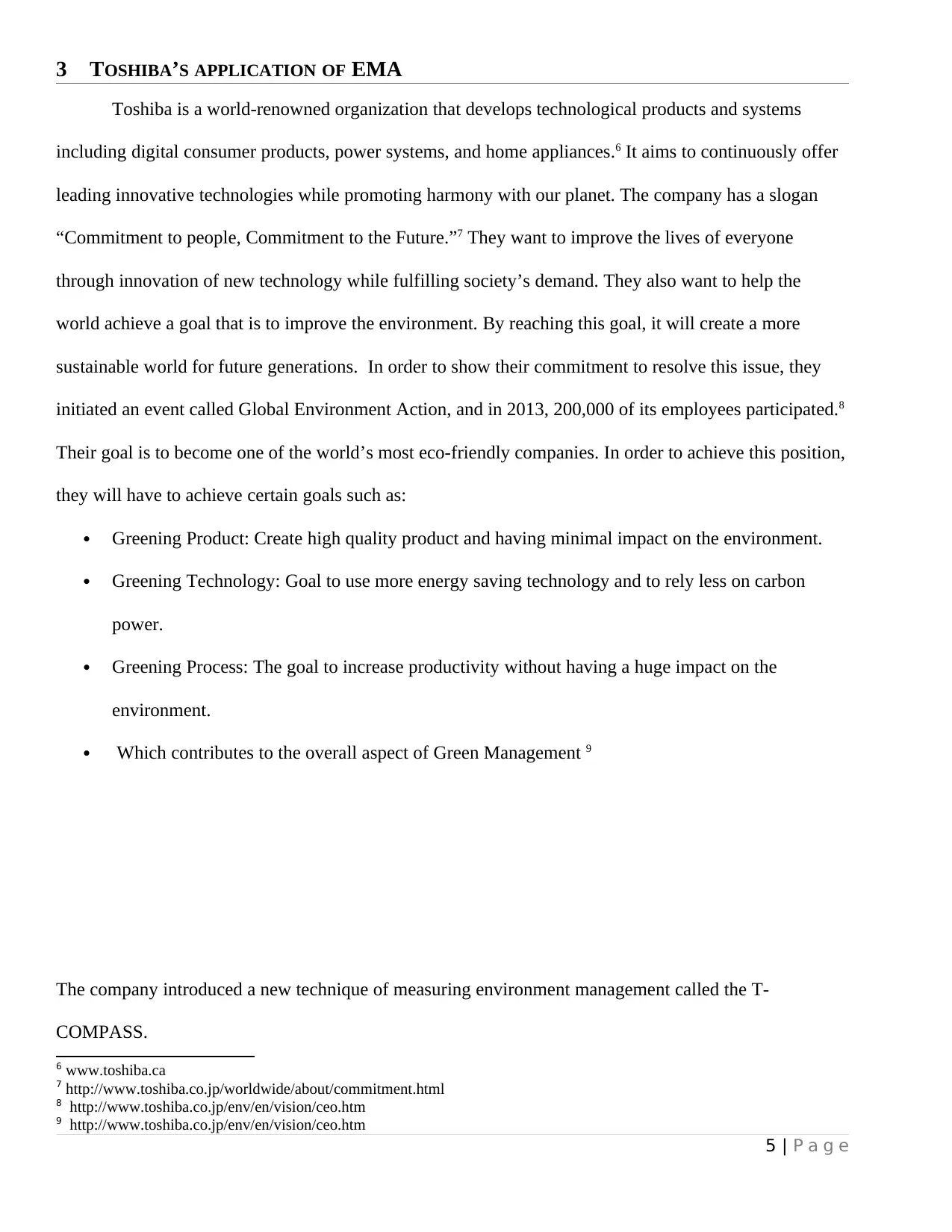
3 TOSHIBA’S APPLICATION OF EMA
Toshiba is a world-renowned organization that develops technological products and systems
including digital consumer products, power systems, and home appliances.6 It aims to continuously offer
leading innovative technologies while promoting harmony with our planet. The company has a slogan
“Commitment to people, Commitment to the Future.”7 They want to improve the lives of everyone
through innovation of new technology while fulfilling society’s demand. They also want to help the
world achieve a goal that is to improve the environment. By reaching this goal, it will create a more
sustainable world for future generations. In order to show their commitment to resolve this issue, they
initiated an event called Global Environment Action, and in 2013, 200,000 of its employees participated.8
Their goal is to become one of the world’s most eco-friendly companies. In order to achieve this position,
they will have to achieve certain goals such as:
Greening Product: Create high quality product and having minimal impact on the environment.
Greening Technology: Goal to use more energy saving technology and to rely less on carbon
power.
Greening Process: The goal to increase productivity without having a huge impact on the
environment.
Which contributes to the overall aspect of Green Management 9
The company introduced a new technique of measuring environment management called the T-
COMPASS.
6 www.toshiba.ca
7 http://www.toshiba.co.jp/worldwide/about/commitment.html
8 http://www.toshiba.co.jp/env/en/vision/ceo.htm
9 http://www.toshiba.co.jp/env/en/vision/ceo.htm
5 | P a g e
Toshiba is a world-renowned organization that develops technological products and systems
including digital consumer products, power systems, and home appliances.6 It aims to continuously offer
leading innovative technologies while promoting harmony with our planet. The company has a slogan
“Commitment to people, Commitment to the Future.”7 They want to improve the lives of everyone
through innovation of new technology while fulfilling society’s demand. They also want to help the
world achieve a goal that is to improve the environment. By reaching this goal, it will create a more
sustainable world for future generations. In order to show their commitment to resolve this issue, they
initiated an event called Global Environment Action, and in 2013, 200,000 of its employees participated.8
Their goal is to become one of the world’s most eco-friendly companies. In order to achieve this position,
they will have to achieve certain goals such as:
Greening Product: Create high quality product and having minimal impact on the environment.
Greening Technology: Goal to use more energy saving technology and to rely less on carbon
power.
Greening Process: The goal to increase productivity without having a huge impact on the
environment.
Which contributes to the overall aspect of Green Management 9
The company introduced a new technique of measuring environment management called the T-
COMPASS.
6 www.toshiba.ca
7 http://www.toshiba.co.jp/worldwide/about/commitment.html
8 http://www.toshiba.co.jp/env/en/vision/ceo.htm
9 http://www.toshiba.co.jp/env/en/vision/ceo.htm
5 | P a g e
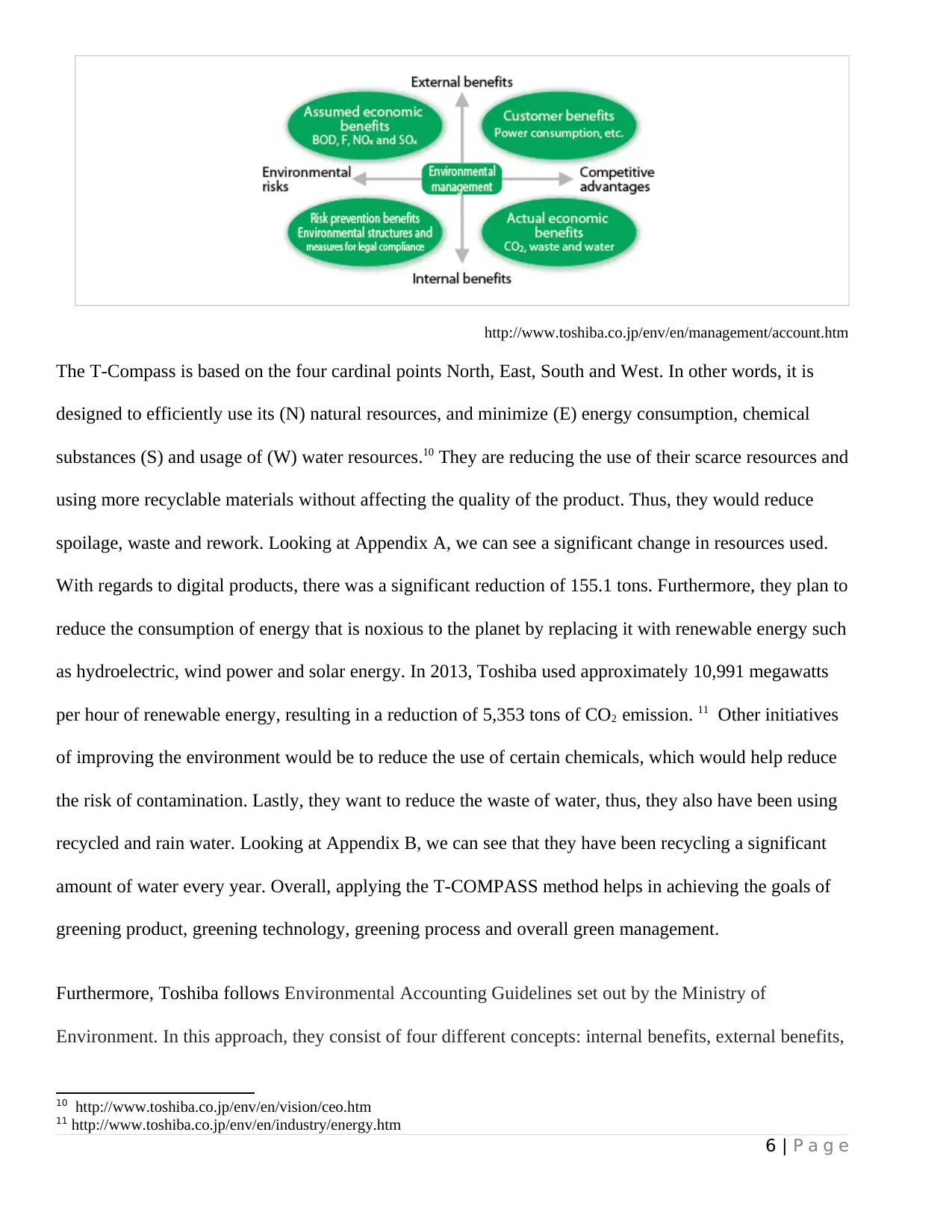
http://www.toshiba.co.jp/env/en/management/account.htm
The T-Compass is based on the four cardinal points North, East, South and West. In other words, it is
designed to efficiently use its (N) natural resources, and minimize (E) energy consumption, chemical
substances (S) and usage of (W) water resources.10 They are reducing the use of their scarce resources and
using more recyclable materials without affecting the quality of the product. Thus, they would reduce
spoilage, waste and rework. Looking at Appendix A, we can see a significant change in resources used.
With regards to digital products, there was a significant reduction of 155.1 tons. Furthermore, they plan to
reduce the consumption of energy that is noxious to the planet by replacing it with renewable energy such
as hydroelectric, wind power and solar energy. In 2013, Toshiba used approximately 10,991 megawatts
per hour of renewable energy, resulting in a reduction of 5,353 tons of CO2 emission. 11 Other initiatives
of improving the environment would be to reduce the use of certain chemicals, which would help reduce
the risk of contamination. Lastly, they want to reduce the waste of water, thus, they also have been using
recycled and rain water. Looking at Appendix B, we can see that they have been recycling a significant
amount of water every year. Overall, applying the T-COMPASS method helps in achieving the goals of
greening product, greening technology, greening process and overall green management.
Furthermore, Toshiba follows Environmental Accounting Guidelines set out by the Ministry of
Environment. In this approach, they consist of four different concepts: internal benefits, external benefits,
10 http://www.toshiba.co.jp/env/en/vision/ceo.htm
11 http://www.toshiba.co.jp/env/en/industry/energy.htm
6 | P a g e
The T-Compass is based on the four cardinal points North, East, South and West. In other words, it is
designed to efficiently use its (N) natural resources, and minimize (E) energy consumption, chemical
substances (S) and usage of (W) water resources.10 They are reducing the use of their scarce resources and
using more recyclable materials without affecting the quality of the product. Thus, they would reduce
spoilage, waste and rework. Looking at Appendix A, we can see a significant change in resources used.
With regards to digital products, there was a significant reduction of 155.1 tons. Furthermore, they plan to
reduce the consumption of energy that is noxious to the planet by replacing it with renewable energy such
as hydroelectric, wind power and solar energy. In 2013, Toshiba used approximately 10,991 megawatts
per hour of renewable energy, resulting in a reduction of 5,353 tons of CO2 emission. 11 Other initiatives
of improving the environment would be to reduce the use of certain chemicals, which would help reduce
the risk of contamination. Lastly, they want to reduce the waste of water, thus, they also have been using
recycled and rain water. Looking at Appendix B, we can see that they have been recycling a significant
amount of water every year. Overall, applying the T-COMPASS method helps in achieving the goals of
greening product, greening technology, greening process and overall green management.
Furthermore, Toshiba follows Environmental Accounting Guidelines set out by the Ministry of
Environment. In this approach, they consist of four different concepts: internal benefits, external benefits,
10 http://www.toshiba.co.jp/env/en/vision/ceo.htm
11 http://www.toshiba.co.jp/env/en/industry/energy.htm
6 | P a g e
⊘ This is a preview!⊘
Do you want full access?
Subscribe today to unlock all pages.

Trusted by 1+ million students worldwide
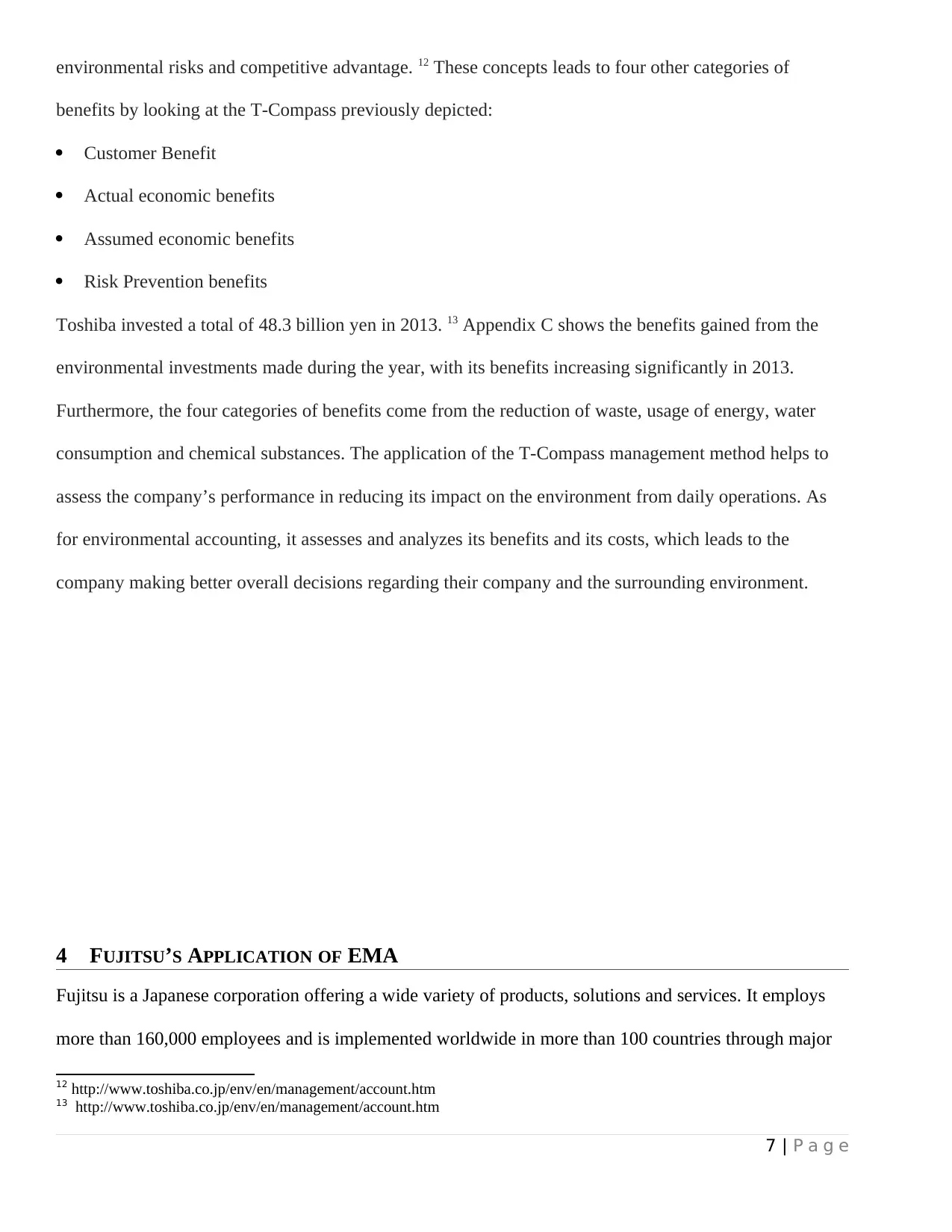
environmental risks and competitive advantage. 12 These concepts leads to four other categories of
benefits by looking at the T-Compass previously depicted:
Customer Benefit
Actual economic benefits
Assumed economic benefits
Risk Prevention benefits
Toshiba invested a total of 48.3 billion yen in 2013. 13 Appendix C shows the benefits gained from the
environmental investments made during the year, with its benefits increasing significantly in 2013.
Furthermore, the four categories of benefits come from the reduction of waste, usage of energy, water
consumption and chemical substances. The application of the T-Compass management method helps to
assess the company’s performance in reducing its impact on the environment from daily operations. As
for environmental accounting, it assesses and analyzes its benefits and its costs, which leads to the
company making better overall decisions regarding their company and the surrounding environment.
4 FUJITSU’S APPLICATION OF EMA
Fujitsu is a Japanese corporation offering a wide variety of products, solutions and services. It employs
more than 160,000 employees and is implemented worldwide in more than 100 countries through major
12 http://www.toshiba.co.jp/env/en/management/account.htm
13 http://www.toshiba.co.jp/env/en/management/account.htm
7 | P a g e
benefits by looking at the T-Compass previously depicted:
Customer Benefit
Actual economic benefits
Assumed economic benefits
Risk Prevention benefits
Toshiba invested a total of 48.3 billion yen in 2013. 13 Appendix C shows the benefits gained from the
environmental investments made during the year, with its benefits increasing significantly in 2013.
Furthermore, the four categories of benefits come from the reduction of waste, usage of energy, water
consumption and chemical substances. The application of the T-Compass management method helps to
assess the company’s performance in reducing its impact on the environment from daily operations. As
for environmental accounting, it assesses and analyzes its benefits and its costs, which leads to the
company making better overall decisions regarding their company and the surrounding environment.
4 FUJITSU’S APPLICATION OF EMA
Fujitsu is a Japanese corporation offering a wide variety of products, solutions and services. It employs
more than 160,000 employees and is implemented worldwide in more than 100 countries through major
12 http://www.toshiba.co.jp/env/en/management/account.htm
13 http://www.toshiba.co.jp/env/en/management/account.htm
7 | P a g e
Paraphrase This Document
Need a fresh take? Get an instant paraphrase of this document with our AI Paraphraser
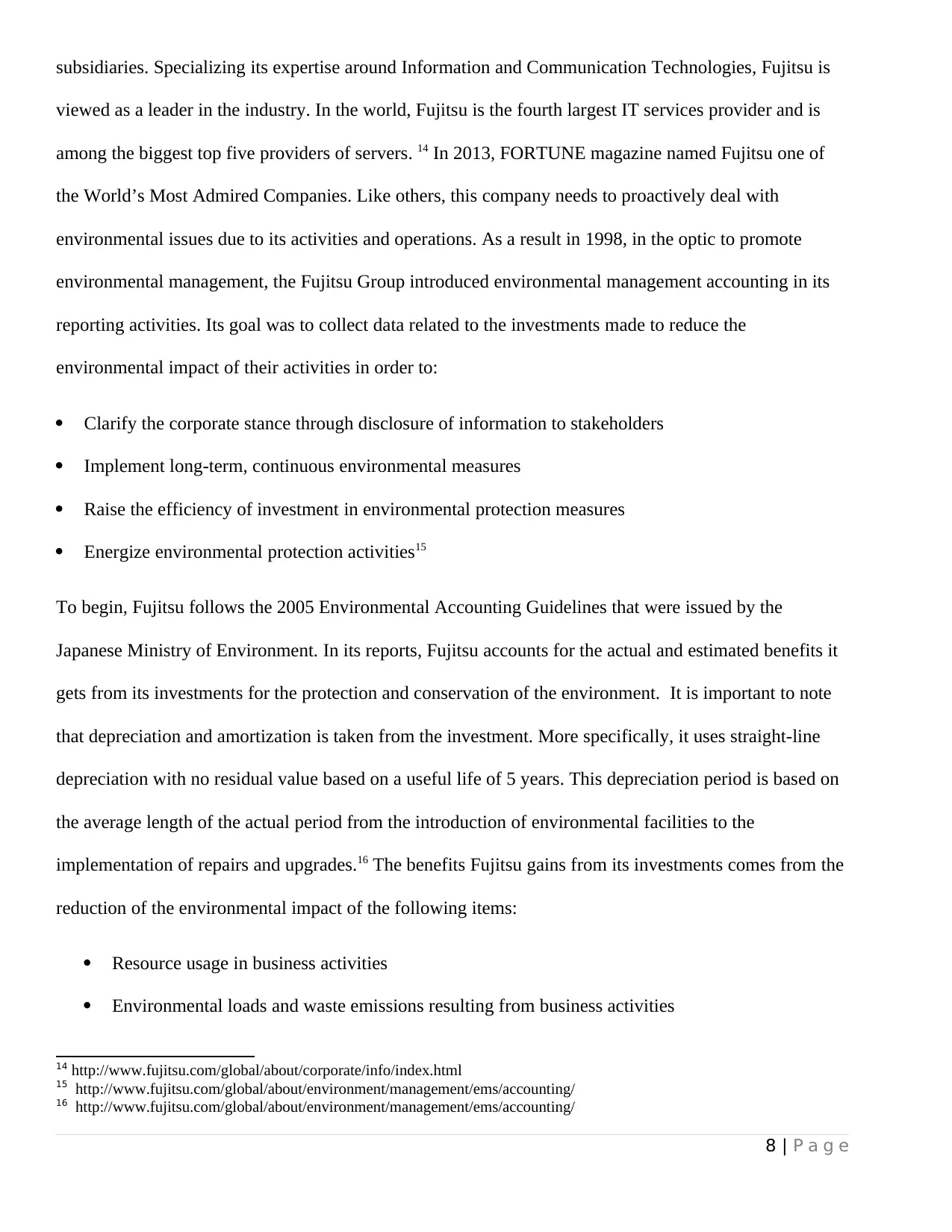
subsidiaries. Specializing its expertise around Information and Communication Technologies, Fujitsu is
viewed as a leader in the industry. In the world, Fujitsu is the fourth largest IT services provider and is
among the biggest top five providers of servers. 14 In 2013, FORTUNE magazine named Fujitsu one of
the World’s Most Admired Companies. Like others, this company needs to proactively deal with
environmental issues due to its activities and operations. As a result in 1998, in the optic to promote
environmental management, the Fujitsu Group introduced environmental management accounting in its
reporting activities. Its goal was to collect data related to the investments made to reduce the
environmental impact of their activities in order to:
Clarify the corporate stance through disclosure of information to stakeholders
Implement long-term, continuous environmental measures
Raise the efficiency of investment in environmental protection measures
Energize environmental protection activities15
To begin, Fujitsu follows the 2005 Environmental Accounting Guidelines that were issued by the
Japanese Ministry of Environment. In its reports, Fujitsu accounts for the actual and estimated benefits it
gets from its investments for the protection and conservation of the environment. It is important to note
that depreciation and amortization is taken from the investment. More specifically, it uses straight-line
depreciation with no residual value based on a useful life of 5 years. This depreciation period is based on
the average length of the actual period from the introduction of environmental facilities to the
implementation of repairs and upgrades.16 The benefits Fujitsu gains from its investments comes from the
reduction of the environmental impact of the following items:
Resource usage in business activities
Environmental loads and waste emissions resulting from business activities
14 http://www.fujitsu.com/global/about/corporate/info/index.html
15 http://www.fujitsu.com/global/about/environment/management/ems/accounting/
16 http://www.fujitsu.com/global/about/environment/management/ems/accounting/
8 | P a g e
viewed as a leader in the industry. In the world, Fujitsu is the fourth largest IT services provider and is
among the biggest top five providers of servers. 14 In 2013, FORTUNE magazine named Fujitsu one of
the World’s Most Admired Companies. Like others, this company needs to proactively deal with
environmental issues due to its activities and operations. As a result in 1998, in the optic to promote
environmental management, the Fujitsu Group introduced environmental management accounting in its
reporting activities. Its goal was to collect data related to the investments made to reduce the
environmental impact of their activities in order to:
Clarify the corporate stance through disclosure of information to stakeholders
Implement long-term, continuous environmental measures
Raise the efficiency of investment in environmental protection measures
Energize environmental protection activities15
To begin, Fujitsu follows the 2005 Environmental Accounting Guidelines that were issued by the
Japanese Ministry of Environment. In its reports, Fujitsu accounts for the actual and estimated benefits it
gets from its investments for the protection and conservation of the environment. It is important to note
that depreciation and amortization is taken from the investment. More specifically, it uses straight-line
depreciation with no residual value based on a useful life of 5 years. This depreciation period is based on
the average length of the actual period from the introduction of environmental facilities to the
implementation of repairs and upgrades.16 The benefits Fujitsu gains from its investments comes from the
reduction of the environmental impact of the following items:
Resource usage in business activities
Environmental loads and waste emissions resulting from business activities
14 http://www.fujitsu.com/global/about/corporate/info/index.html
15 http://www.fujitsu.com/global/about/environment/management/ems/accounting/
16 http://www.fujitsu.com/global/about/environment/management/ems/accounting/
8 | P a g e
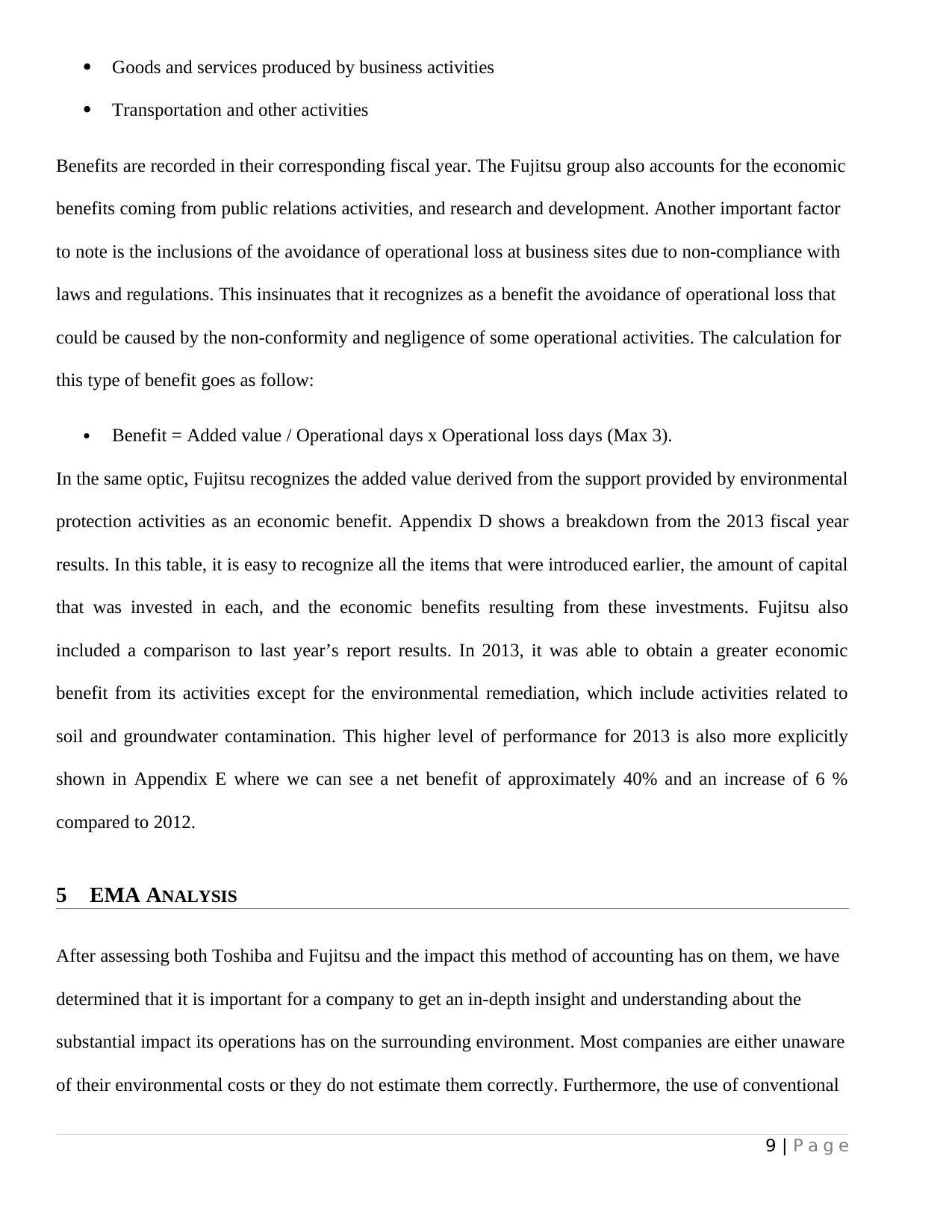
Goods and services produced by business activities
Transportation and other activities
Benefits are recorded in their corresponding fiscal year. The Fujitsu group also accounts for the economic
benefits coming from public relations activities, and research and development. Another important factor
to note is the inclusions of the avoidance of operational loss at business sites due to non-compliance with
laws and regulations. This insinuates that it recognizes as a benefit the avoidance of operational loss that
could be caused by the non-conformity and negligence of some operational activities. The calculation for
this type of benefit goes as follow:
Benefit = Added value / Operational days x Operational loss days (Max 3).
In the same optic, Fujitsu recognizes the added value derived from the support provided by environmental
protection activities as an economic benefit. Appendix D shows a breakdown from the 2013 fiscal year
results. In this table, it is easy to recognize all the items that were introduced earlier, the amount of capital
that was invested in each, and the economic benefits resulting from these investments. Fujitsu also
included a comparison to last year’s report results. In 2013, it was able to obtain a greater economic
benefit from its activities except for the environmental remediation, which include activities related to
soil and groundwater contamination. This higher level of performance for 2013 is also more explicitly
shown in Appendix E where we can see a net benefit of approximately 40% and an increase of 6 %
compared to 2012.
5 EMA ANALYSIS
After assessing both Toshiba and Fujitsu and the impact this method of accounting has on them, we have
determined that it is important for a company to get an in-depth insight and understanding about the
substantial impact its operations has on the surrounding environment. Most companies are either unaware
of their environmental costs or they do not estimate them correctly. Furthermore, the use of conventional
9 | P a g e
Transportation and other activities
Benefits are recorded in their corresponding fiscal year. The Fujitsu group also accounts for the economic
benefits coming from public relations activities, and research and development. Another important factor
to note is the inclusions of the avoidance of operational loss at business sites due to non-compliance with
laws and regulations. This insinuates that it recognizes as a benefit the avoidance of operational loss that
could be caused by the non-conformity and negligence of some operational activities. The calculation for
this type of benefit goes as follow:
Benefit = Added value / Operational days x Operational loss days (Max 3).
In the same optic, Fujitsu recognizes the added value derived from the support provided by environmental
protection activities as an economic benefit. Appendix D shows a breakdown from the 2013 fiscal year
results. In this table, it is easy to recognize all the items that were introduced earlier, the amount of capital
that was invested in each, and the economic benefits resulting from these investments. Fujitsu also
included a comparison to last year’s report results. In 2013, it was able to obtain a greater economic
benefit from its activities except for the environmental remediation, which include activities related to
soil and groundwater contamination. This higher level of performance for 2013 is also more explicitly
shown in Appendix E where we can see a net benefit of approximately 40% and an increase of 6 %
compared to 2012.
5 EMA ANALYSIS
After assessing both Toshiba and Fujitsu and the impact this method of accounting has on them, we have
determined that it is important for a company to get an in-depth insight and understanding about the
substantial impact its operations has on the surrounding environment. Most companies are either unaware
of their environmental costs or they do not estimate them correctly. Furthermore, the use of conventional
9 | P a g e
⊘ This is a preview!⊘
Do you want full access?
Subscribe today to unlock all pages.

Trusted by 1+ million students worldwide
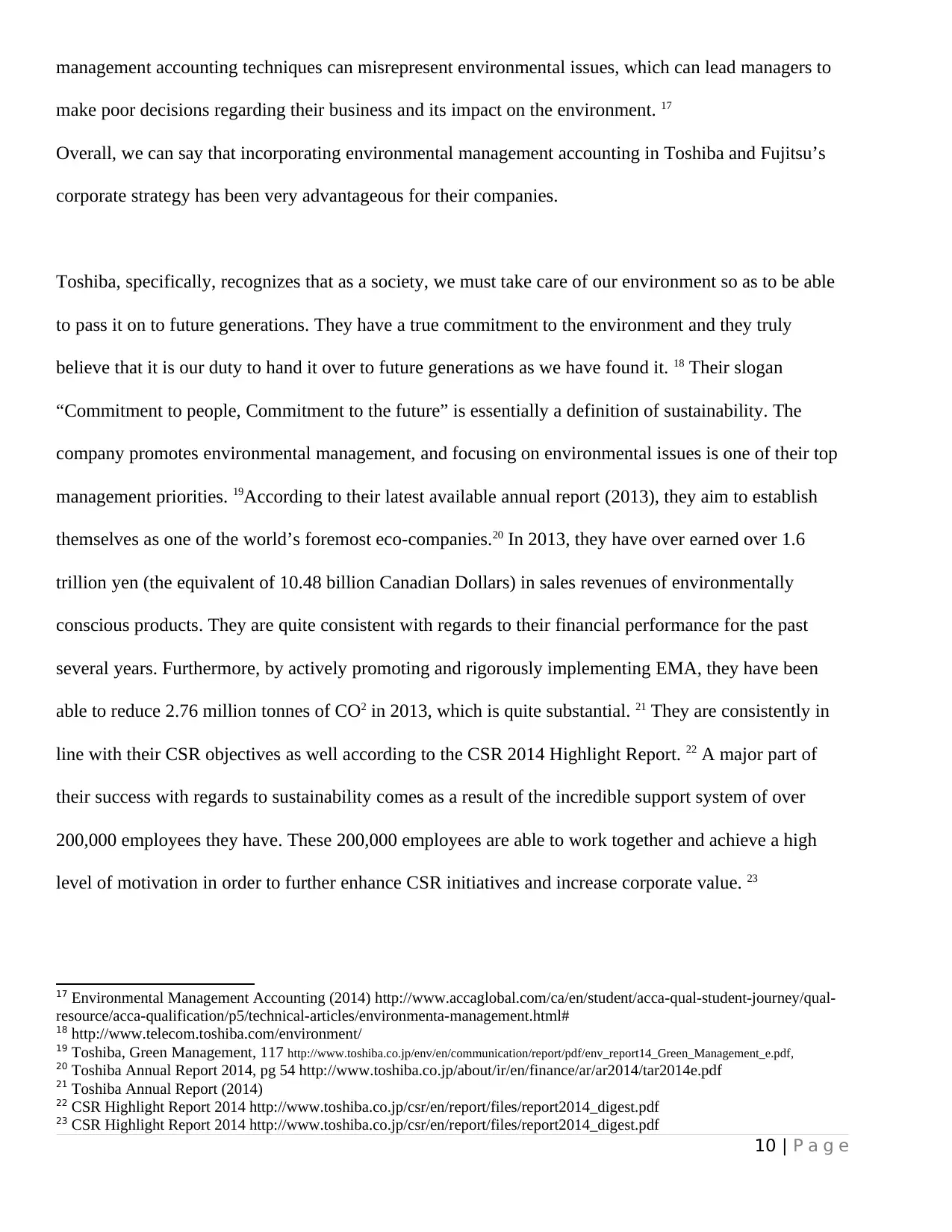
management accounting techniques can misrepresent environmental issues, which can lead managers to
make poor decisions regarding their business and its impact on the environment. 17
Overall, we can say that incorporating environmental management accounting in Toshiba and Fujitsu’s
corporate strategy has been very advantageous for their companies.
Toshiba, specifically, recognizes that as a society, we must take care of our environment so as to be able
to pass it on to future generations. They have a true commitment to the environment and they truly
believe that it is our duty to hand it over to future generations as we have found it. 18 Their slogan
“Commitment to people, Commitment to the future” is essentially a definition of sustainability. The
company promotes environmental management, and focusing on environmental issues is one of their top
management priorities. 19According to their latest available annual report (2013), they aim to establish
themselves as one of the world’s foremost eco-companies.20 In 2013, they have over earned over 1.6
trillion yen (the equivalent of 10.48 billion Canadian Dollars) in sales revenues of environmentally
conscious products. They are quite consistent with regards to their financial performance for the past
several years. Furthermore, by actively promoting and rigorously implementing EMA, they have been
able to reduce 2.76 million tonnes of CO2 in 2013, which is quite substantial. 21 They are consistently in
line with their CSR objectives as well according to the CSR 2014 Highlight Report. 22 A major part of
their success with regards to sustainability comes as a result of the incredible support system of over
200,000 employees they have. These 200,000 employees are able to work together and achieve a high
level of motivation in order to further enhance CSR initiatives and increase corporate value. 23
17 Environmental Management Accounting (2014) http://www.accaglobal.com/ca/en/student/acca-qual-student-journey/qual-
resource/acca-qualification/p5/technical-articles/environmenta-management.html#
18 http://www.telecom.toshiba.com/environment/
19 Toshiba, Green Management, 117 http://www.toshiba.co.jp/env/en/communication/report/pdf/env_report14_Green_Management_e.pdf,
20 Toshiba Annual Report 2014, pg 54 http://www.toshiba.co.jp/about/ir/en/finance/ar/ar2014/tar2014e.pdf
21 Toshiba Annual Report (2014)
22 CSR Highlight Report 2014 http://www.toshiba.co.jp/csr/en/report/files/report2014_digest.pdf
23 CSR Highlight Report 2014 http://www.toshiba.co.jp/csr/en/report/files/report2014_digest.pdf
10 | P a g e
make poor decisions regarding their business and its impact on the environment. 17
Overall, we can say that incorporating environmental management accounting in Toshiba and Fujitsu’s
corporate strategy has been very advantageous for their companies.
Toshiba, specifically, recognizes that as a society, we must take care of our environment so as to be able
to pass it on to future generations. They have a true commitment to the environment and they truly
believe that it is our duty to hand it over to future generations as we have found it. 18 Their slogan
“Commitment to people, Commitment to the future” is essentially a definition of sustainability. The
company promotes environmental management, and focusing on environmental issues is one of their top
management priorities. 19According to their latest available annual report (2013), they aim to establish
themselves as one of the world’s foremost eco-companies.20 In 2013, they have over earned over 1.6
trillion yen (the equivalent of 10.48 billion Canadian Dollars) in sales revenues of environmentally
conscious products. They are quite consistent with regards to their financial performance for the past
several years. Furthermore, by actively promoting and rigorously implementing EMA, they have been
able to reduce 2.76 million tonnes of CO2 in 2013, which is quite substantial. 21 They are consistently in
line with their CSR objectives as well according to the CSR 2014 Highlight Report. 22 A major part of
their success with regards to sustainability comes as a result of the incredible support system of over
200,000 employees they have. These 200,000 employees are able to work together and achieve a high
level of motivation in order to further enhance CSR initiatives and increase corporate value. 23
17 Environmental Management Accounting (2014) http://www.accaglobal.com/ca/en/student/acca-qual-student-journey/qual-
resource/acca-qualification/p5/technical-articles/environmenta-management.html#
18 http://www.telecom.toshiba.com/environment/
19 Toshiba, Green Management, 117 http://www.toshiba.co.jp/env/en/communication/report/pdf/env_report14_Green_Management_e.pdf,
20 Toshiba Annual Report 2014, pg 54 http://www.toshiba.co.jp/about/ir/en/finance/ar/ar2014/tar2014e.pdf
21 Toshiba Annual Report (2014)
22 CSR Highlight Report 2014 http://www.toshiba.co.jp/csr/en/report/files/report2014_digest.pdf
23 CSR Highlight Report 2014 http://www.toshiba.co.jp/csr/en/report/files/report2014_digest.pdf
10 | P a g e
Paraphrase This Document
Need a fresh take? Get an instant paraphrase of this document with our AI Paraphraser
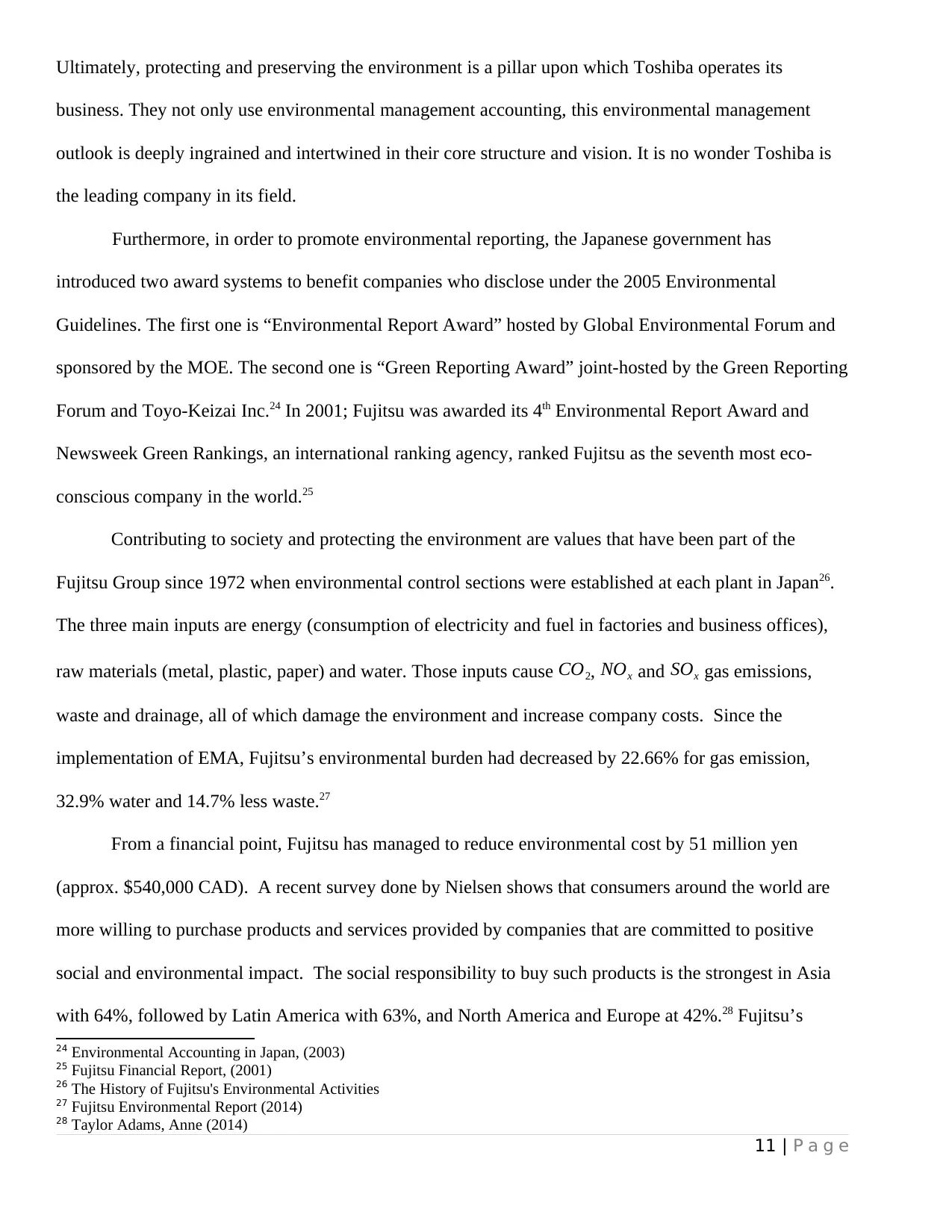
Ultimately, protecting and preserving the environment is a pillar upon which Toshiba operates its
business. They not only use environmental management accounting, this environmental management
outlook is deeply ingrained and intertwined in their core structure and vision. It is no wonder Toshiba is
the leading company in its field.
Furthermore, in order to promote environmental reporting, the Japanese government has
introduced two award systems to benefit companies who disclose under the 2005 Environmental
Guidelines. The first one is “Environmental Report Award” hosted by Global Environmental Forum and
sponsored by the MOE. The second one is “Green Reporting Award” joint-hosted by the Green Reporting
Forum and Toyo-Keizai Inc.24 In 2001; Fujitsu was awarded its 4th Environmental Report Award and
Newsweek Green Rankings, an international ranking agency, ranked Fujitsu as the seventh most eco-
conscious company in the world.25
Contributing to society and protecting the environment are values that have been part of the
Fujitsu Group since 1972 when environmental control sections were established at each plant in Japan26.
The three main inputs are energy (consumption of electricity and fuel in factories and business offices),
raw materials (metal, plastic, paper) and water. Those inputs cause CO2, NOx and SOx gas emissions,
waste and drainage, all of which damage the environment and increase company costs. Since the
implementation of EMA, Fujitsu’s environmental burden had decreased by 22.66% for gas emission,
32.9% water and 14.7% less waste.27
From a financial point, Fujitsu has managed to reduce environmental cost by 51 million yen
(approx. $540,000 CAD). A recent survey done by Nielsen shows that consumers around the world are
more willing to purchase products and services provided by companies that are committed to positive
social and environmental impact. The social responsibility to buy such products is the strongest in Asia
with 64%, followed by Latin America with 63%, and North America and Europe at 42%.28 Fujitsu’s
24 Environmental Accounting in Japan, (2003)
25 Fujitsu Financial Report, (2001)
26 The History of Fujitsu's Environmental Activities
27 Fujitsu Environmental Report (2014)
28 Taylor Adams, Anne (2014)
11 | P a g e
business. They not only use environmental management accounting, this environmental management
outlook is deeply ingrained and intertwined in their core structure and vision. It is no wonder Toshiba is
the leading company in its field.
Furthermore, in order to promote environmental reporting, the Japanese government has
introduced two award systems to benefit companies who disclose under the 2005 Environmental
Guidelines. The first one is “Environmental Report Award” hosted by Global Environmental Forum and
sponsored by the MOE. The second one is “Green Reporting Award” joint-hosted by the Green Reporting
Forum and Toyo-Keizai Inc.24 In 2001; Fujitsu was awarded its 4th Environmental Report Award and
Newsweek Green Rankings, an international ranking agency, ranked Fujitsu as the seventh most eco-
conscious company in the world.25
Contributing to society and protecting the environment are values that have been part of the
Fujitsu Group since 1972 when environmental control sections were established at each plant in Japan26.
The three main inputs are energy (consumption of electricity and fuel in factories and business offices),
raw materials (metal, plastic, paper) and water. Those inputs cause CO2, NOx and SOx gas emissions,
waste and drainage, all of which damage the environment and increase company costs. Since the
implementation of EMA, Fujitsu’s environmental burden had decreased by 22.66% for gas emission,
32.9% water and 14.7% less waste.27
From a financial point, Fujitsu has managed to reduce environmental cost by 51 million yen
(approx. $540,000 CAD). A recent survey done by Nielsen shows that consumers around the world are
more willing to purchase products and services provided by companies that are committed to positive
social and environmental impact. The social responsibility to buy such products is the strongest in Asia
with 64%, followed by Latin America with 63%, and North America and Europe at 42%.28 Fujitsu’s
24 Environmental Accounting in Japan, (2003)
25 Fujitsu Financial Report, (2001)
26 The History of Fujitsu's Environmental Activities
27 Fujitsu Environmental Report (2014)
28 Taylor Adams, Anne (2014)
11 | P a g e
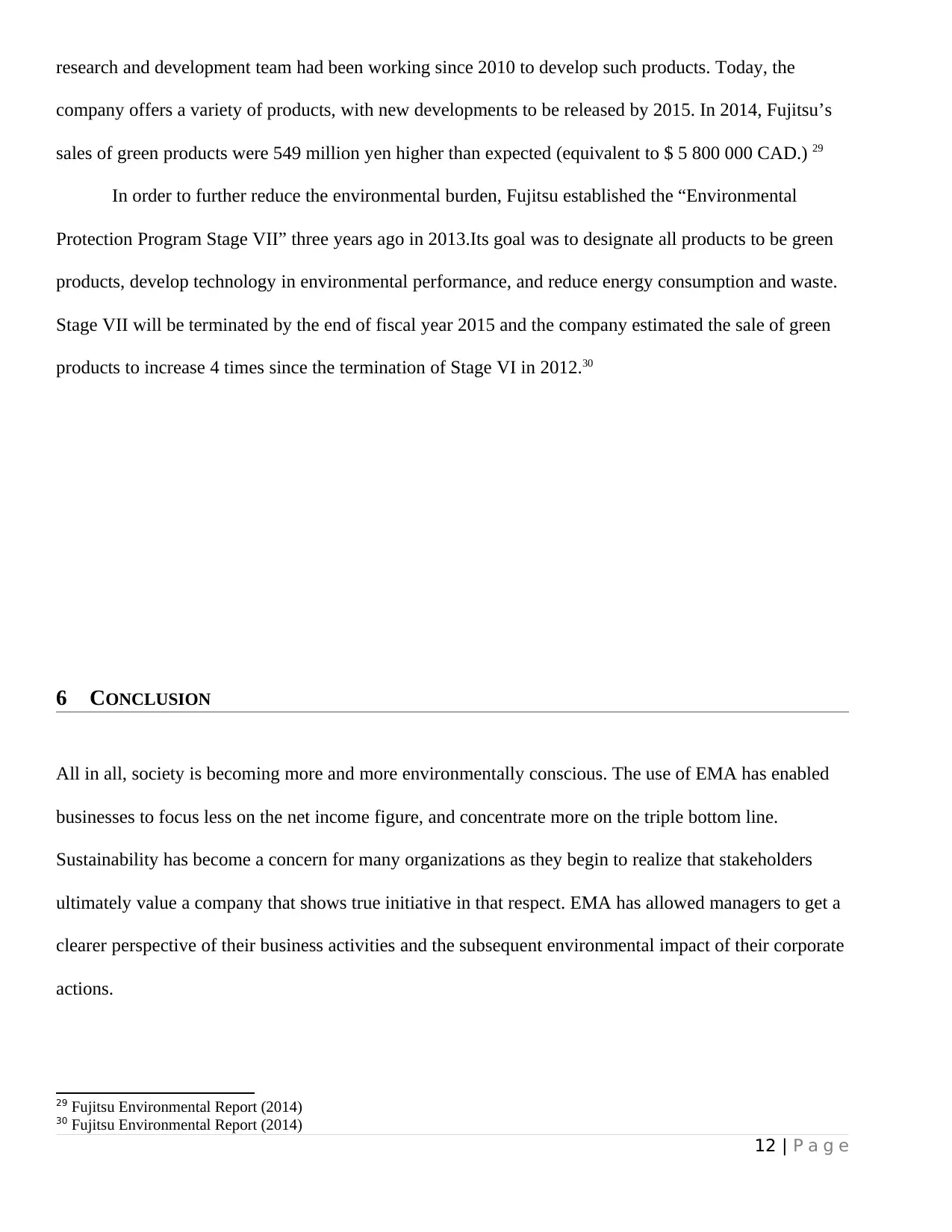
research and development team had been working since 2010 to develop such products. Today, the
company offers a variety of products, with new developments to be released by 2015. In 2014, Fujitsu’s
sales of green products were 549 million yen higher than expected (equivalent to $ 5 800 000 CAD.) 29
In order to further reduce the environmental burden, Fujitsu established the “Environmental
Protection Program Stage VII” three years ago in 2013.Its goal was to designate all products to be green
products, develop technology in environmental performance, and reduce energy consumption and waste.
Stage VII will be terminated by the end of fiscal year 2015 and the company estimated the sale of green
products to increase 4 times since the termination of Stage VI in 2012.30
6 CONCLUSION
All in all, society is becoming more and more environmentally conscious. The use of EMA has enabled
businesses to focus less on the net income figure, and concentrate more on the triple bottom line.
Sustainability has become a concern for many organizations as they begin to realize that stakeholders
ultimately value a company that shows true initiative in that respect. EMA has allowed managers to get a
clearer perspective of their business activities and the subsequent environmental impact of their corporate
actions.
29 Fujitsu Environmental Report (2014)
30 Fujitsu Environmental Report (2014)
12 | P a g e
company offers a variety of products, with new developments to be released by 2015. In 2014, Fujitsu’s
sales of green products were 549 million yen higher than expected (equivalent to $ 5 800 000 CAD.) 29
In order to further reduce the environmental burden, Fujitsu established the “Environmental
Protection Program Stage VII” three years ago in 2013.Its goal was to designate all products to be green
products, develop technology in environmental performance, and reduce energy consumption and waste.
Stage VII will be terminated by the end of fiscal year 2015 and the company estimated the sale of green
products to increase 4 times since the termination of Stage VI in 2012.30
6 CONCLUSION
All in all, society is becoming more and more environmentally conscious. The use of EMA has enabled
businesses to focus less on the net income figure, and concentrate more on the triple bottom line.
Sustainability has become a concern for many organizations as they begin to realize that stakeholders
ultimately value a company that shows true initiative in that respect. EMA has allowed managers to get a
clearer perspective of their business activities and the subsequent environmental impact of their corporate
actions.
29 Fujitsu Environmental Report (2014)
30 Fujitsu Environmental Report (2014)
12 | P a g e
⊘ This is a preview!⊘
Do you want full access?
Subscribe today to unlock all pages.

Trusted by 1+ million students worldwide
1 out of 20
Related Documents
Your All-in-One AI-Powered Toolkit for Academic Success.
+13062052269
info@desklib.com
Available 24*7 on WhatsApp / Email
![[object Object]](/_next/static/media/star-bottom.7253800d.svg)
Unlock your academic potential
Copyright © 2020–2025 A2Z Services. All Rights Reserved. Developed and managed by ZUCOL.





